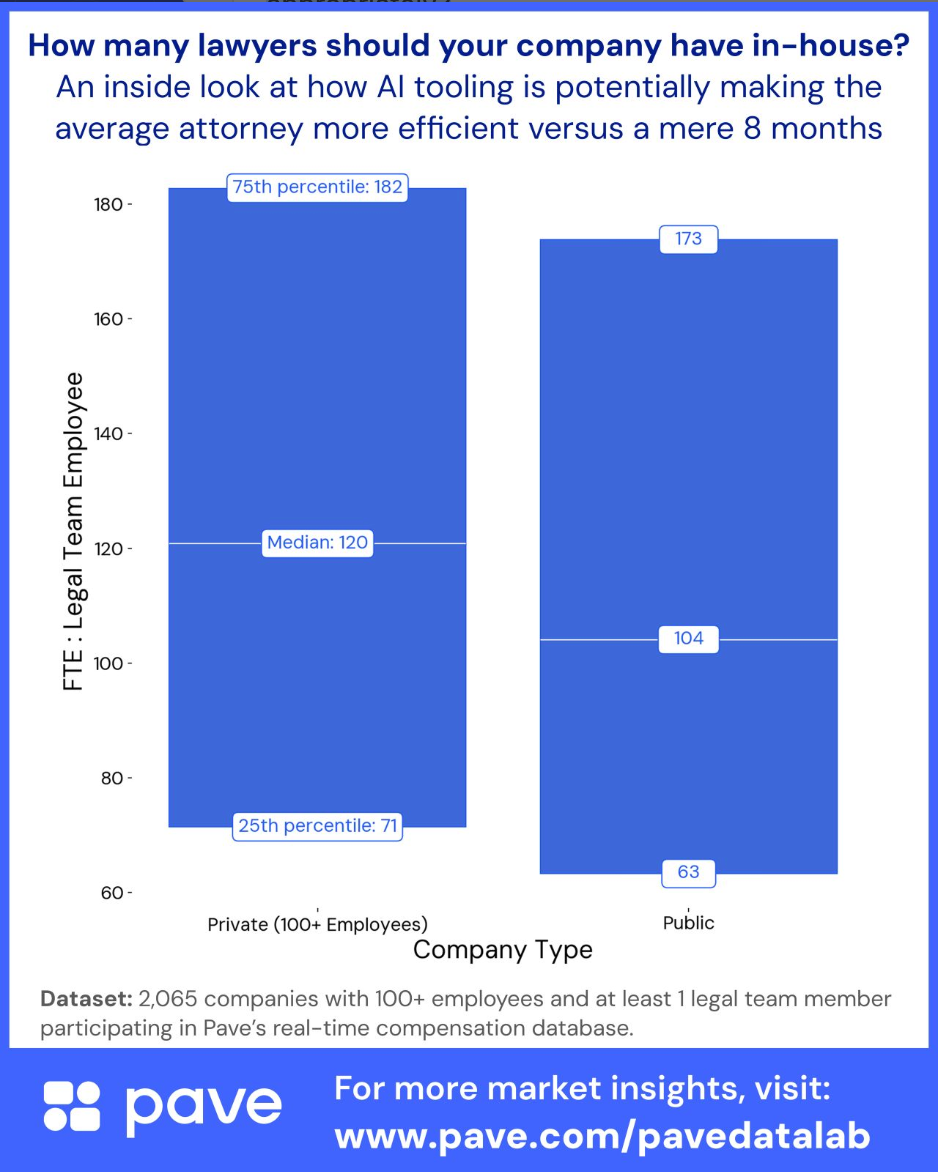Note: This article was originally published November 8, 2024. It has been updated to include current benchmarks as of September 2025.
The size of an organization’s legal team of course depends so much on the nature of your company, what you sell, and how you sell it.
This said, let’s dive into the data from Pave’s customer base to uncover some benchmarks.
Here, we’ll look at the benchmarks for full-time employees (FTEs) per legal team member, similar to the approach we took when analyzing data on HRBPs, and examine how this is changing over time—potentially due to advances in AI tooling.
What are the key factors influencing legal team size?
To begin, let’s explore some of the factors that can influence the size of a company’s legal team, or the lawyer-to-FTE ratio. Here are a few:
- Company Size and Stage: Early-stage startups (sub ~100 full-time employees) typically have very few in-house lawyers and often rely on external legal firms.
- Product Complexity: Companies with more complex IP (e.g., SaaS companies, hardware companies) may require more legal support for patent protection, licensing agreements, etc.
- Global Presence: Companies expanding internationally will likely need more lawyers to handle local compliance, data privacy (e.g., GDPR), and employment laws across different regions.
- Legal Focus: Tech companies in highly regulated areas (e.g., health data, financial services, telecom) tend to have larger legal teams to address the regulatory complexity.
How large should a legal team be?
In late 2024, we looked at the findings from 1,800+ analyzed Pave customers. This analysis considers all Legal Team Members, from IC attorneys all the way up to General Counsel. We also split up the results for private companies (with at least 100 employees) and public companies. As a reminder, Pave’s dataset skews heavily tech.

The data showed that at private companies with 100+ employees, the size of the legal team ranged from 63 full-time employees per legal employee at the 25th percentile all the way to 169 full-time employees per legal employee at the 75th percentile. The median sat at one lawyer for every 109 FTEs.
At public companies, the legal team size was the same at the low end, with 63 full-time employees per legal employee at the 25th percentile. However, at the 75th percentile, these companies had 155 full-time employees per legal employee, and the median was 92 FTEs per legal employee.
{{mid-cta}}
Is AI impacting legal team size?
In September of 2025, we took a look at the latest employee-to-attorney benchmarks to compare them to the respective benchmarks from eight months ago.
The big question: Is the influx of new AI tools for attorneys potentially making the median attorney more efficient and “loaded”?

The findings show the average in-house lawyer is now more “loaded” or “efficient”. From eight months ago to today, the private company 50th percentile has increased from 109 to 120 FTEs-per-legal-employee. And the public company 50th percentile has increased from 92 to 104 FTEs-per-legal-employee.
This suggests that companies are becoming increasingly efficient with their in-house legal headcount spend.
Two potentially related forces may be at play:
- The ongoing efforts of companies to make their org charts more efficient coming out of the ZIRP era
- The ongoing productivity improvements for lawyers linked with the influx of new legal AI tooling
We also see that public companies generally have more lawyers on staff as a proportion of total employees than private companies.
Again, we hypothesize two potentially related forces:
- Private companies may be more willing to rely more heavily on outside counsel as their legal teams get established
- The ongoing duties of operating a public company may warrant more holistic legal spend
For compensation and HR leaders, this raises a couple of questions. How does your legal team's ratio compare to these benchmarks? And is your company’s legal team adopting the latest AI productivity tooling appropriately?
Matt Schulman is CEO and founder of Pave, the complete platform for Total Rewards professionals. Prior to Pave, he was a software engineer at Facebook focusing on user-centric mobile experiences. A self-proclaimed "comp nerd," Matt is known for sharing data-driven thought leadership around all things compensation and personal finance.
.avif)
.jpg)

.jpg)



.jpg)